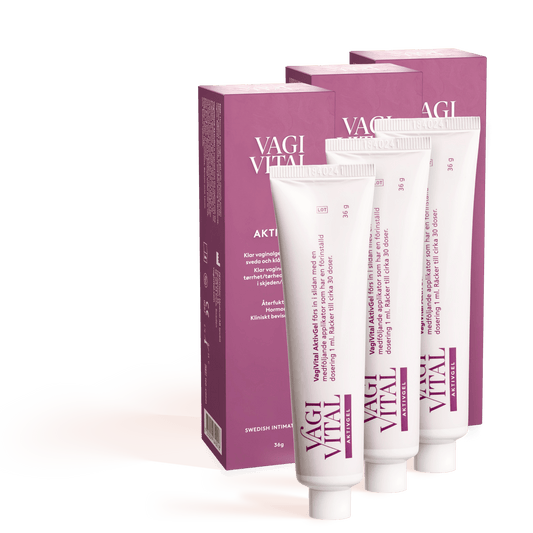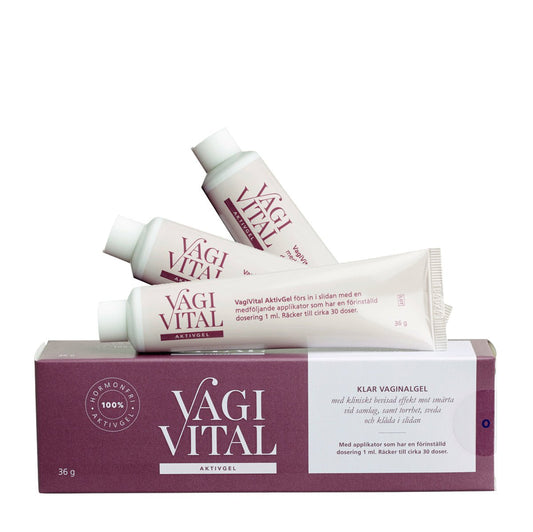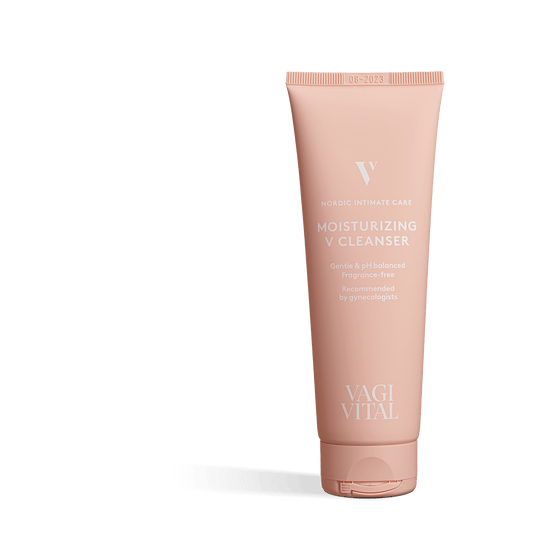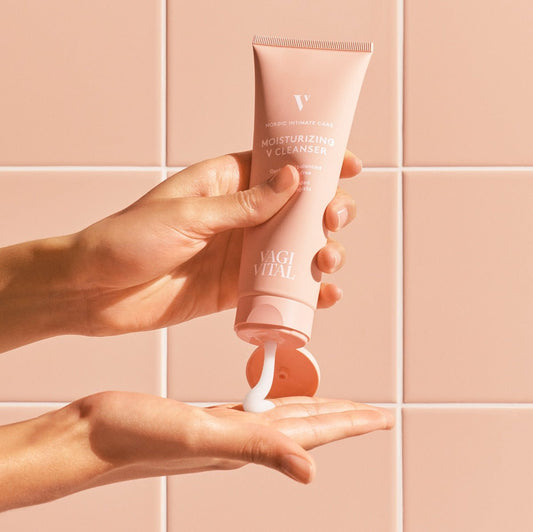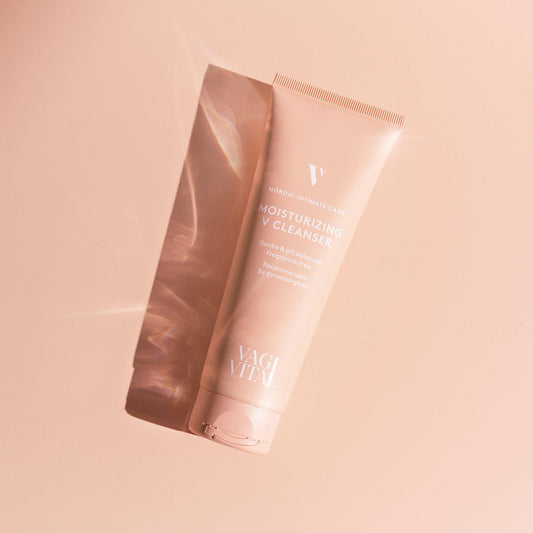How does the VagiVital AL Self-Test for amniotic fluid leakage work?
Rebecka Kaplan Sturk, senior consultant in gynecology/obstetrics, writes about VagiVital AL Self-test for amniotic fluid leakage and its applications for pregnant women, at midwife clinics and delivery wards.
Background
In about 10% of full-term pregnancies, spontaneous rupture of membranes occurs before labor begins. Premature rupture of membranes, defined as rupture before 37 completed weeks of gestation, affects about 2-4% of singleton pregnancies and 7-20% of twin pregnancies¹. Usually, a large flow of fluid occurs at the time of amniotic fluid rupture, or a steady dripping flow, making the diagnosis straightforward. Diagnosis becomes more difficult in cases where the amniotic fluid leakage is very sparse or intermittent.
Differential diagnoses for rupture of membranes when the pregnant woman experiences heavy moisture in her underwear include normal discharge, bacterial vaginosis, cervical mucus, or urinary leakage. As many as 30-40% of pregnant women experience urinary leakage late in pregnancy². It is estimated that 20% of pregnant women seek care at delivery due to suspected rupture of membranes, and 50% of them are sent home with the assessment that the wetness was due to urinary leakage.
The risk of undiagnosed rupture of membranes is ascending infections from the vagina into the uterine cavity, which in turn can lead to complications for both mother and child (severe infection in the uterus or placenta, fever, sepsis in the mother, pneumonia in the child). On the other hand, a false positive diagnosis of rupture of membranes can lead to unnecessary medical interventions and procedures such as hospitalization, medication with antibiotics or corticosteroids, or induction of labor.
In 47% of cases, doctors are uncertain about the diagnosis of rupture of membranes based solely on clinical examination and the patient's history³.
The Product
VagiVital AL Self-test is a pad/liner that detects pH 6.5 and ammonia levels in fluid. The pad contains a polymer-embedded strip that changes color from yellow to blue or green when amniotic fluid is detected. It can detect even very small amounts of amniotic fluid and has been tested on amniotic fluid from gestational week 16⁴. When the pad feels wet, it is removed, and the result is read after 15 minutes. In case of urinary leakage, the strip remains yellow.
Clinical studies show a sensitivity of 97.06%, a specificity of 96.92%, a positive predictive value of 96.92%, and a negative predictive value of 97.67%⁵,⁶,⁷. Studies also show that the reliability of reading the test result is the same for healthcare personnel as for the pregnant woman herself6.
An independent calculation performed by the External Assessment Centre (EAC) based on three studies of VagiVital AL Self-test shows a sensitivity of 97%, specificity of 79%, and a positive predictive value of 96%. The rate of false negative tests of 3-4% with VagiVital AL Self-test was assessed to be at the same level as the rate of false negative vaginal examinations with sterile instruments; 3.8-3.9%.⁸
Possible Applications and Advantages
Since the method is non-invasive and easy to use and read, VagiVital AL Self-test could be used at midwife clinics to screen for rupture of membranes when pregnant women seek care for unclear leakage or moisture in underwear. In this way, only those with a positive test would need to be sent to the hospital for examination and further management. This would relieve specialist maternity care and delivery wards and reduce unnecessary outpatient visits. VagiVital AL Self-test could also be used in delivery wards in situations where so little water leaks or the leakage is so intermittent that a regular vaginal examination does not detect rupture of membranes. The woman could then be given an AL Self-test pad to take home and instructed to contact care if it changes to blue/green.
After amniotic fluid sampling for fetal diagnostics in the second trimester, amniotic fluid leakage is very common. VagiVital AL Self-test could in those situations be used to detect when the amniotic fluid leakage stops, allowing the pregnant woman to start moving and living normally again.
Possible Disadvantages of the Product
The method detects pH levels above 6.5, so false positive results can occur with bacterial vaginosis. However, it is recommended that pregnant women with bacterial vaginosis be treated with antibiotics to reduce the risk of premature rupture of membranes. That the method signals rupture of membranes in bacterial vaginosis and the pregnant woman is referred to the hospital for examination need not be negative at all. On the contrary, it can lead to treatment that reduces complication risks.
VagiVital AL Self-test cannot be used in case of bleeding or blood-stained discharge/rupture of membranes. It also cannot be used within 12 hours after vaginal intercourse.
Clinical Usability
The method currently used in Sweden to rule out suspicion of, or confirm rupture of membranes, is a vaginal examination with sterile instruments. It is time-consuming, takes up space in specialist maternity care or delivery wards, and for pregnant women in rural areas can mean unnecessary travel. At some delivery clinics in Sweden, AmniSure® is used as a complement to the examination. It is a monoclonal antibody test that detects the glycoprotein PAMG-1. Sensitivity and specificity for AmniSure® are higher than with AL-SENSE (99% compared to 97%, and 87.5-100% compared to 79-96%)⁹. However, the method is used sparingly and only in selected cases, as the test costs about 200 SEK. It is also a more complicated and staff-demanding test as it involves inserting a cotton swab into the vagina, rotating it, and then placing it in a test tube. VagiVital AL Self-test admittedly has a lower specificity, meaning we risk more false positive results, but since the most important thing is not to miss any case of rupture of membranes, the method is considered sufficiently good. It is easier to use, can be sent home with the pregnant woman or easily performed at midwife clinics, and is thus a more user-friendly product in outpatient care, at midwife clinics, and especially in rural areas than AmniSure®.
The method behind VagiVital AL Self-test and the finished product have been evaluated by the UK National Institute for Health and Care (NICE) as part of the Medical Technologies Evaluation Programme (MTEP)8. Their assessment was that the method, when used by a midwife or other healthcare personnel, is supported by evidence. Available evidence indicates that the method can be used to exclude amniotic fluid leakage as a cause of wetness in underwear during pregnancy and thereby enable avoidance of examination with instruments. NICE further assessed that the method can be used in outpatient care to avoid unnecessary referrals and hospital visits. Furthermore, NICE assessed that the method and product should be considered for use in women with unexplained vaginal fluid, and that the method is cost-effective. When the product is used by a midwife in outpatient care, £24 is saved (for rupture of membranes at term) and £18.25 (for premature rupture of membranes, before week 37). Note that these are calculations of costs in the British healthcare system; it is unclear what this corresponds to in the Swedish healthcare system.
If you work in maternity or delivery care and wish to order VagiVital AL for amniotic fluid leakage, click here.
1. Di Renzo G C et al. Guidelines for the management of spontaneous preterm labor: identification of spontaneous preterm labor, diagnosis of preterm premature rupture of membranes, and preventive tools for preterm birth. The Journal of Maternal-Fetal and Neonatal Medicine, May 2011; 24(5):659-667
2. Kristiansson P et al. Reproductive hormones and stress incontinence in pregnancy. Acta Obstet Gynecol Scand. 2001 Dec; 80(12): 1125-30
3. Neil PRL et al. Is AmniSure® useful in the management of women with prelabor rupture of the membranes? Aust N Z J Ostet Gynaecol. 2010 Dec; 50(6): 534-8
4. Odeh M et al, The AL-SENSE Test is Reliable for Detection of Second Trimester Amniotic Fluid. Int J Clin Med 2011, 2, 307-309
5. Bornstein J et al, Nonintrusive diagnosis of premature ruptures amniotic membranes using a novel polymer. Am J Perinatol 2006 Aug; 23(6):351-4
6. Bornstein J et al, Effectiveness of a novel home-based testing device for the detection of rupture of membranes. Am J Perinatol 2009 Jan; 26(1):45-50
7. Madhu M et al. Detection of Aniotic Fluid Leakage in Women with Suspicion of Prelabour Rupture of Membrane or Unexplained Vaginal Wetness by Amniotic Fluid Detection Kit and its Comparison with Fern Test. Sch Acad J Biosci, 2014; 2(9): 573-576
8. Ray A F et al. Vision Amniotic Leak Detector (ALD) to eliminate Amniotic Fluid Leakage as a Cause of Vaginal Wetness in Pregnancy: A NICE Medical Technology Guidance. Appl Health Econ Health Policy (2015) 13:445-456
9. Elci E et al. Comparison of the accuracy and reliability of the AmniSure, AMNIOQUICK, and AL -SENSE tests for early diagnosis of premature rupture of membranes. Int J Gynec Obstet; Vol 149, Issue 1: 93-97
Recommended products for you
- Choosing a selection results in a full page refresh.
- Opens in a new window.


